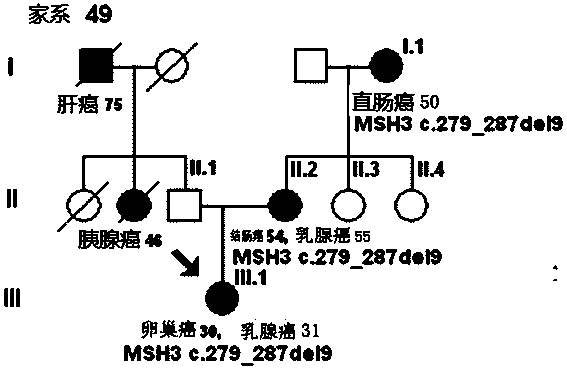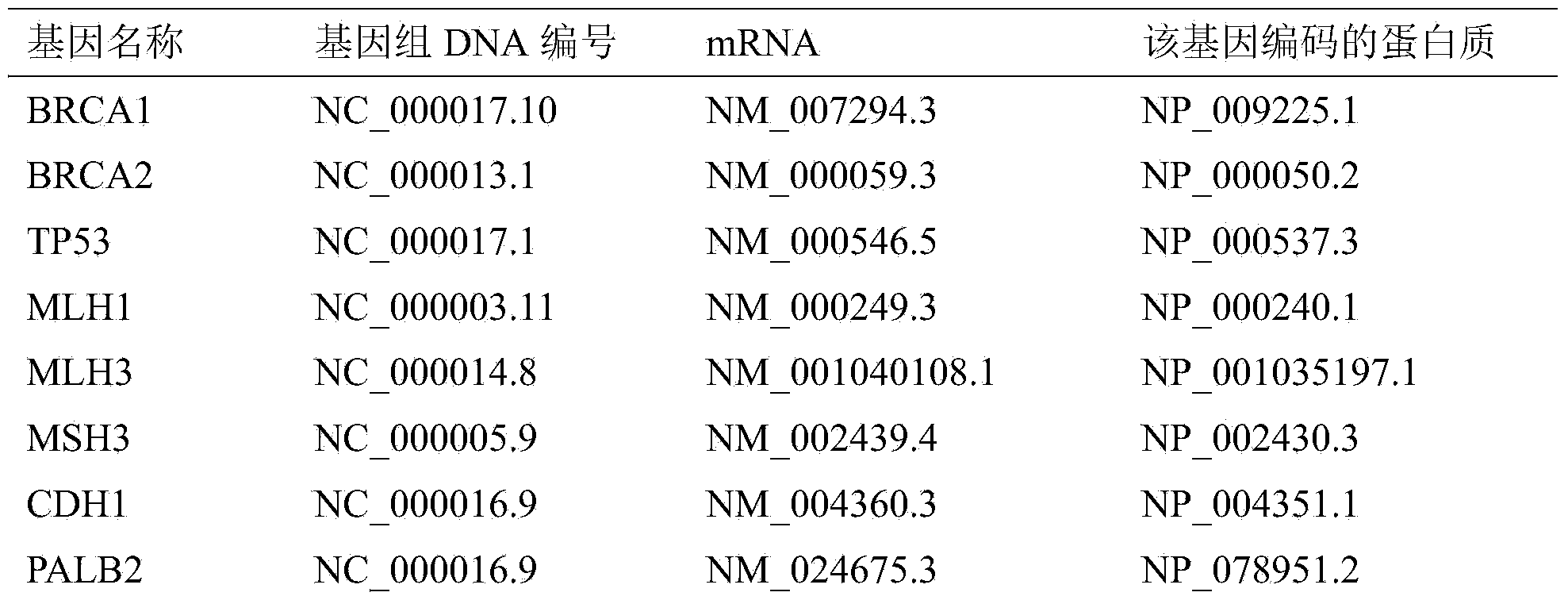Mutant gene group for mammary cancer risk assessment and detection kit thereof
A technology for detecting kits and mutant genes, which is applied in the determination/inspection of microorganisms, recombinant DNA technology, DNA/RNA fragments, etc., which can solve the problems of method limitations and achieve high detection efficiency, high detection rate, and fast detection speed Effect
- Summary
- Abstract
- Description
- Claims
- Application Information
AI Technical Summary
Problems solved by technology
Method used
Image
Examples
Embodiment 1
[0044] Example 1 Screening of hereditary breast cancer susceptibility genes in Chinese population
[0045] Materials and methods:
[0046] From June 2011 to July 2012, among patients with breast cancer who were treated in the Cancer Hospital Affiliated to Fudan University, according to the following inclusion criteria, we performed continuous enrollment.
[0047] The inclusion criteria were: age of onset of breast cancer patients ≤35 years old, and at least one blood relative who was also a malignant tumor patient; age of onset of breast cancer >35 years old, but ≤50 years old, and at least two relatives of the same side (paternal lineage) or maternal line) blood relatives are also malignant tumors; breast cancer onset age > 50 years old, and at least 3 blood relatives on the same side (paternal or maternal line) are also malignant tumors.
[0048] The patient's medical history and family history were collected through questionnaires, and 5ml of peripheral blood was collected...
Embodiment 2
[0145] The primers needed for the synthetic kit of embodiment 2
[0146] Primer synthesis: The following primers were designed for the mutation sites described in the present invention, as shown in Table 7. For the primer sequences, please refer to SEQ ID NO: 1 to SEQ ID NO: 152 in the sequence listing.
[0147] Table 7 Tumor mutation site primers
[0148]
[0149]
[0150]
[0151]
[0152]
[0153]
[0154]
[0155]
[0156] The meaning of Ex-Fw and Ex-Rv primers in Table 7 is the first pair of PCR primers in the nested PCR, and the meaning of In-Fw and In-Rv primers is the nested primers in the nested PCR reaction.
[0157] Utilize the primers shown in Table 7 to perform nested PCR on the patient's genomic DNA. The reaction system and reaction program of the nested PCR are conventional techniques in the art, and the nested PCR reaction program can be appropriately adjusted according to the size of the target fragment, and used The resulting PCR produc...
Embodiment 3
[0158] Example 3 Prepare the probes required for the detection kit
[0159] The capture target region of the gene is shown in Table 1: select the exon coding region of the gene to be tested and some flanking intron regions, and use the Agilent Sureselect XT Custom Kit (700Kb-34Mb) (the kit was purchased from Agilent Technologies, Inc. ) to design a probe, the sequence of the obtained probe is the same as or complementary to the gene sequence carrying the pathogenic mutation site shown in Table 4, please refer to the instruction manual of the kit for the design method of the probe.
PUM
 Login to View More
Login to View More Abstract
Description
Claims
Application Information
 Login to View More
Login to View More - R&D
- Intellectual Property
- Life Sciences
- Materials
- Tech Scout
- Unparalleled Data Quality
- Higher Quality Content
- 60% Fewer Hallucinations
Browse by: Latest US Patents, China's latest patents, Technical Efficacy Thesaurus, Application Domain, Technology Topic, Popular Technical Reports.
© 2025 PatSnap. All rights reserved.Legal|Privacy policy|Modern Slavery Act Transparency Statement|Sitemap|About US| Contact US: help@patsnap.com



